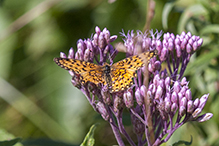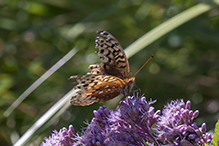silver-bordered fritillary
(Boloria myrina)
Conservation • Description • Habitat • Ecology • Distribution • Taxonomy
|
|
|||||||||||||
Description |
Silver-bordered fritillary is a medium-sized lesser fritillary butterfly. Adults are 1⅜″ to 2⅛″ in length and have a wingspan of 1 9 ⁄16″. Females are larger than males. The upper sides of both wings are bright orange with heavy, sharply demarcated black dots, chain markings, jagged lines, and chevrons. The outer margins have a heavy black band enclosing a row of orange marginal spots. Each of the marginal spots is capped by a black, inward-pointing chevron. The forewing is rounded at the tip. The black marginal band often almost completely eliminates the orange marginal spots. Rarely, the orange marginal spots of the forewing and hindwing are completely eliminated by black. There is diffuse black scaling at the base of both wings. On the hindwing it usually obscures the basal spot in the discal area. The forewing veins are black. The underside of the forewing is dull orange in the basal and medial areas, lighter yellowish-orange in the postmedial area. Black markings mirror the markings on the upper side. There is a large cinnamon-brown patch at the wing tip, and a cinnamon-brown marginal band partially enclosing a row of silvery-white marginal spots. Each of the marginal spots is capped by a black or cinnamon-brown, inward-pointing chevron. The underside of the hindwing is cinnamon-brown in the basal portion, tan in the median area, and cinnamon-brown in the postmedial and marginal areas. There is a marginal row of large white spots; a submarginal row of small black spots; and postmedial row of large. polygonal, white spots; and medial and basal rows of large, polygonal, some silvery white, some cream-colored spots. All of the marginal spots and postmedial spots are solid, prominent, and well silvered. The lower middle post-medial (Cu2) white spot is seldom divided. There is also a single small black spot in the discal area with an orange center and a silvery-white outline. The female is slightly paler and has less heavy markings. The orange marginal spots are more conspicuous. The above description refers to the northern subspecies B. s. atrocostalis. On the eastern subspecies, B. s. myrina, the black markings are not as dark. The marginal band is not heavy, and all of the orange marginal spots are visible on both wings. The caterpillar is about ⅞″ long. The body is variable in color, greenish, pinkish-brown, or brownish-black. Each abdominal segment has 5 pale, orangish-brown, spike-like projections (scoli), one on the upper (dorsal) surface, and on each side one in the subdorsal area and one in the spiracular area. The spines just behind the head are very long and horn-like. There is a black spot at the base of each scolus. Mature caterpillars are found from Late May to September. |
Size |
Total length: 1⅜″ to 2⅛″ Wingspan: 1 9 ⁄16″ |
Similar Species |
Habitat |
Marshes, bogs, swamps, wet meadows, and fields adjacent to wetlands |
Ecology |
Season |
Two broods: Mid-May to June and July to early September |
Behavior |
|
Life Cycle |
The female lays pale green eggs singly on stems or leaves of a plant near or on a host violet. The eggs quickly turn light brown and hatch after about nine days. Third stage (instar) caterpillars hibernate in late August and overwinter. They continue their development the following spring, and pupate in May. Adults emerge in about ten days. |
Larva Hosts |
Leaves of violets (Viola spp.) |
Adult Food |
Nectar of flowers in the aster (Asteraceae) family |
Distribution |
||
|
Sources 7, 21, 27, 29, 30, 71, 75, 82, 83. Dark-bordered fritillary (Boloria myrina atrocostalis) is common and is found in the northern half of the state. Myrina fritillary (Boloria myrina myrina) is uncommon in Minnesota and is restricted to the southern half of the state. The two subspecies intergrade along a narrow band where their ranges overlap. |
|
| 6/15/2025 | ||
Occurrence |
||
In Minnesota, fairly common in the north, uncommon in the south. |
||
Taxonomy |
|
Order |
|
Superfamily |
Papilionoidea (Butterflies) |
Family |
|
Subfamily |
Heliconiinae (fritillaries and longwings) |
Tribe |
|
Subtribe |
Argynnina |
Genus |
Boloria (lesser fritillaries) |
Subgenus |
Clossiana |
Species split |
|
Subordinate Taxa |
|
dark-bordered fritillary (Boloria myrina atrocostalis) Kohler’s fritillary (Boloria myrina sabulocollis) Myrina fritillary (Boloria myrina myrina) Nebraska fritillary (Boloria myrina nebraskensis) silver-bordered fritillary (Boloria myrina albequina) silver-bordered fritillary (Boloria myrina terranovae) Tolland fritillary (Boloria myrina tollandensis) |
|
Synonyms |
|
Clossiana selene |
|
Common Names |
|
silver-bordered fritillary |
|
Glossary
Instar
The developmental stage of arthropods between each molt; in insects, the developmental stage of the larvae or nymph.
Scolus
A spiny, branched projection from a larval body wall, the branches terminating with a single stiff, hair-like or bristle-like tip. Plural: scoli.
Spiracle
A small opening on the surface of an insect or arachnid through which it breathes.
Visitor Photos |
||
Share your photo of this insect. |
||
This button not working for you? |
||
|
||
MinnesotaSeasons.com Photos |
||
 |
 |
|
Upper side |
Upper side |
|
 |
 |
|
Upper side |
||
|
||
|
||
|
Upper side |
|
 |
 |
|
Underside |
Underside |
|
 |
||
Underside |
|

Slideshows |
|

Visitor Videos |
||
Share your video of this insect. |
||
This button not working for you? |
||
|
Other Videos |
||
Silver-bordered Fritillary |
About
Published on Aug 21, 2012 Seen on August 19,2012 |
Small Pearl Bordered Fritillary |
About
Published on Dec 30, 2008 Forest Lodge July 2006 |
Small Pearl-bordered Fritillary |
About
Published on Jun 20, 2014 |

Visitor Sightings |
||
Report a sighting of this insect. |
||
This button not working for you? |
||
|
|
MinnesotaSeasons.com Sightings |
||

Created: 8/20/2019 Last Updated: © MinnesotaSeasons.com. All rights reserved. |
